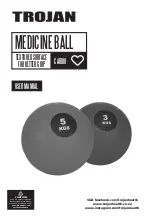
CCD
Operator's manual
Page 27 /35
the table and close the remaining fixing holes with foil or screws. The MDF is permeable to air, but
you can enhance the vacuum effect by drilling small suction holes in the MDF.
Vacuum fixation is handy when processing flexible and semi-flexible materials. However, a pos-
sible bow in the board and tolerances in the material is not compensated. Thus the use of the
depth limiter is still recommended.
Drilling bare boards
When making double sided PCBs with chemical through hole plating, the first step is to drill the
holes. Any photo processing of tracks and pads will follow later.
Use a raw cut piece of copper clad laminate and put it, together with a base sheet of the same
size, on the machine table. Align to the X- or Y-axis and fix like described under "clamp fixing".
Alternative: Use a big base sheet and fix it by use of the plastic disks. Put the board to be drilled
on top and push it to the machine's zero position. Using adhesive tape, fix the board to the base
sheet. Advantage: The fixture position is independent from the board size. The adhesive tape can
be drilled through without damage to the drill.
Pre-sensitized base material
In the same way as above, pre-sensitized base material still covered with its protection foil may be
drilled
prior to exposure
. As to our experience, this gives best results: There is only one position-
ing operation necessary at exposure time. The drilled image will perfectly fit the etched board
structures. If possible produce your artwork with
transparent drill holes
in the pads. This will
make the referencing process very simply.
Etched PCBs
The board already shows the tracks and pads. The drilling must exactly fit the pads.
When doing the layout, insert 2 or 3 reference holes with an extra tool number and diameter (use
reference hole function of IsoCam). Use a fresh base sheet and drill these reference holes into it.
Press steel pins or rivets into the holes and use this sheet as base sheet later when processing
the boards.
Use the OFFSET command to move the machine's zero position to any place on the table. Fix the
raw cut bare PCB to this location. Drill the reference holes related to the above used tool. Use the
reference holes to position the film artwork. Develop and etch as usual. To drill the board, return to
the machine and fix the board to the reference pins of the prepared base sheet.
If the film artwork does not exactly fit the drill coordinates, use the SCALE edit fields to enlarge or
reduce the drill image size.
Routing
Also for routing a base sheet is strongly recommended! Fix the plate by span or clamp fixing. Pay
attention that it lies straight and even.
If, for example, there is a circle to be routed in FR4 material, the inner part of it will most certainly
remain where it was on the base sheet. This will of course work only if you use a sharp router and
set an appropriate speed. In IsoCam you can place gaps in the cut out. These “bridges” prevent
the cut outs to be propelled away.
Engraving
The engraving front panels requires a good flatness of the board. Otherwise, the font thickness
varies with the depth of penetration of the V-cut-router. Here is a safe clamp fixation indispens-
able. For engraving you can work with the depth limiter. However, in this case the cooling is less
efficient, because the milling tool is almost completely enclosed. Another trick is to bend the en-
graving plate a bit, so the the sides of the plate point upward. Now, when you span down both
sides the engraving plate will lie flat on the base.









































